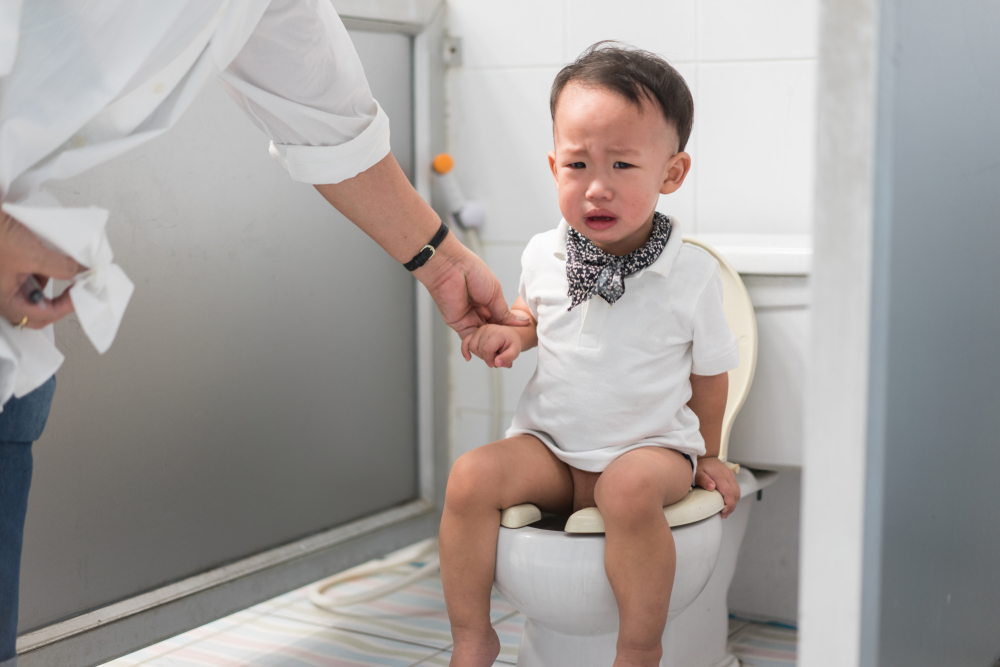These can be tricky to spot. Your child may be constipated if:
● They don't open their bowels at least 3 times a week
● Their bowel movement are often large, hard and difficult to push out
● Their bowel movement looks like rabbit droppings or little pellets
● If your child is potty trained, soiled pants can be another sign of constipation. This is
because runny bowel movement (diarrhoea) may leak out around the hard, constipated stool. This
is called overflow soiling
If your child is constipated, they may find it painful to open their bowel. This can create a cycle: the more
it hurts, the more they hold on . The more constipated they get, the more it hurts and
so on. Even if pooing isn't painful, once your child is really constipated they may try to avoid
going to the toilet altogether.
Constipation
Constipation
Constipation is common in childhood, particularly when children are being potty trained at around 2 to 3 years old.
Tummy pain is common with constipation. If you are worried about this please look at the abdominal pain page.

Make sure your child has plenty to drink. Offer breastfed babies who aren’t eating solids yet
plenty of breastfeeds. Formula fed babies can have extra drinks of water between their
formula feeds. See more advice on drinks for babies and toddlers.
Give your child a variety of foods including plenty of fruit and vegetables, which are a good
source of fibre. See what to feed young children.
Encourage your child to be physically active. For more information, read the physical activity
guidelines for children aged under 5 years.
Get your child into a routine of regularly sitting on the potty or toilet after meals or before
bed (for 5 minutes). Praise them whether or not they go. This is particularly important for
boys who may forget once they are weeing standing up. Reward schemes
appropriate for age are important; as is consistency and patience.
Make sure your child can rest their feet flat on the floor or on a step when they're using the
potty or toilet to get them in a good position. Take a look at this leaflet for a
picture of how to sit to get the "it in the loo"!
Ask if they feel worried about using the potty or toilet. Some children don';t want to go in
certain situations, such as at nursery or school.
Stay positive and reassuring, so that your child doesn't see going to the toilet as a stressful
situation. You want your child to see it as a normal part of life, not something to be
ashamed of.
Firstly, try to stay calm. Getting constipated and soiling their clothes isn't something your
child is doing on purpose, so there';s no reason to get cross with them.
Staying positive and
relaxed is the best attitude to help your child and praising positive steps is important.
If your child is potty training, they may be feeling anxious or stressed about using the toilet.
This can cause them to hold it in and lead to constipation. Give your child plenty of
time to use the toilet while they are still learning.
Encourage them when they do use the
toilet. Some parents find a reward chart works.
If you think your child is having difficulty
with toilet training, you can also chat to your health visitor.
If your child remains constipated despite the advice above, speak to their GP who can
decide if they need medicines. The treatment for constipation depends on your child’s age.
The longer your child is constipated, the longer it can take to get back to normal. Make sure
you get help early.
If your child develops new or more severe tummy ache please see our page on tummy ache
Laxatives are often recommended for children, alongside diet and lifestyle changes.
It may take several months for the treatments to work. Keep trying until they do.
Remember that laxative treatment may make your child's overflow soiling worse for a time before it
gets better - so consider the impact, for example on school trips.
Once your child's constipation has improved, it's important to stop it coming back.
Your GP may advise that your child keeps taking laxatives for a while to make sure it stays
soft enough to push out regularly.
The medicines are safe and don’t cause a lazy bowel.
More information and support:
Contact the ERIC helpline on 0808 1699 949 (free to call from mobile and landline), Monday
to Thursday 10am to 2pm.
ERIC's guide to children's bowel problems.
Contact your local community pharmacist.
They are able to offer advice
about a range of healthy living matters which includes eating a healthy diet. They can also
provide information leaflets and give parents, carers, and young people more information
about other organisations that might be able to also help with healthy eating.
Please click here.




